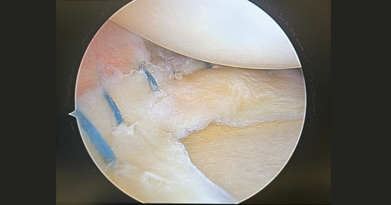Author: Travis Fortin, MD
Published on: 12/19/2023
If you are experiencing symptoms in your knee such as catching, popping, clicking, locking when trying to bend or straighten your knee, swelling, or pain with deep bending such as squats or stairs, then you may have a torn meniscus. The meniscus lines the joint line and acts like a shock absorber in your knee. It helps spread the pressure out from the weight of your body as you stand, walk or run. This is very important because it helps protect the soft lining of your knee joint called cartilage from too much pressure over time. With a damaged meniscus, the increased pressure will cause faster wear and tear to your knee (also known as arthritis, which is a major cause of joint pain).
There are a few ways to help fix the meniscus to get your knee on the path to start feeling better and prevent the faster wear and tear to your knee. The way we fix the tear depends on the type and location of the tear. If the tear is able to be repaired, then we use stitches inside the knee to sew the tear back together. This will allow the meniscus to heal and restore its normal shape. Figure 1 shows a bucket handle tear of the meniscus. In this case, we opted to repair the meniscus (Figure 2) to restore knee biomechanics. If the tear is not able to be sewn back together, then we trim the edges and smooth out the meniscus similar to trimming a hangnail on your finger.

Figure 1

Figure 2
The surgery is minimally invasive with skin cuts less than one inch long and are about the size of the width of your fingernail. If the meniscus is repaired, you will typically use crutches for mobility after surgery. You typically will not put full weight immediately after surgery to protect the repair. By six weeks, you will be able to place full weight on your leg without crutches. We also have you work with physical therapy to build back the strength and range of motion in your knee. This will help get your knee back to its usual self. The recovery time can take approximately 4 months before your knee feels back to normal.
Despite the increased time for recovery and more difficult rehab, you should consider getting your meniscus repaired if appropriately indicated. Repairing the meniscus may decrease the rate of arthritis and pain in your knee long term. The younger and higher demand individual you are, the more important it is to preserve your meniscus.


